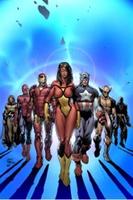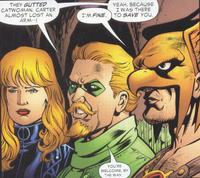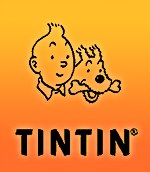Vol. 1, No. 2
- - - - - - - - - - - - - - - - - - - - - - - - - - - - - - - - - - - - - - - - - - - - - - - - In this issue:
In this issue:
reviews of The New Avengers #7 and All-Star Batman and Robin the Boy Wonder #1 / notes on serial killers in New Avengers, Teen Titans alums Blackfire and Omen, Johns and Heinberg's JLA, and more / rants about Ben Mulroney and the joy of hate
- - - - - - - - - - - - - - - - - - - - - - - - - - - - - - - - - - - - - - - - - - - - - - - -
reviews
The New Avengers #7 Brian Michael Bendis (Writer) / Steve McNiven (Penciller) / Mark Morales (Inker) Those who are still reading Bendis’s enjoyable rebuilding of the Avengers (after he took a crude but much-needed wrecking ball to the creaky series last year) are buzzing about issue seven’s metafictional cliffhanger. Frankly, this “twist” gave me the sinking feeling that Bendis-bashers are about to be vindicated. The hallmark of Bendis’s writing is a kind of jaunty, knowing banter that is undeniably gratifying for fanboy readers like yours truly. But nothing ruins a good adventure/mystery story like the jarring introduction of self-consciousness into the plotting itself, which drops from the sky here like an anvil. Many comic books (including superhero books) have done ingenious, very amusing things with metafiction in the past--in fact the medium itself is so profoundly interactive and self-conscious that the term metafiction almost seems redundant. Still, Bendis has spent six issues crafting a wonderfully fresh take on the team that manages to feel realistic and over-the-top all at once, and it’s a shame to burst the bubble of this fantasy so soon (or indeed, at all). There’s a difference between dialogue that winks at the audience and plotting that punches them in the face; I hope that Bendis is going to make me look like a doubting Thomas and surprise all the naysayers by keeping this daring re-invention of Marvel’s best team book on the rails.
Those who are still reading Bendis’s enjoyable rebuilding of the Avengers (after he took a crude but much-needed wrecking ball to the creaky series last year) are buzzing about issue seven’s metafictional cliffhanger. Frankly, this “twist” gave me the sinking feeling that Bendis-bashers are about to be vindicated. The hallmark of Bendis’s writing is a kind of jaunty, knowing banter that is undeniably gratifying for fanboy readers like yours truly. But nothing ruins a good adventure/mystery story like the jarring introduction of self-consciousness into the plotting itself, which drops from the sky here like an anvil. Many comic books (including superhero books) have done ingenious, very amusing things with metafiction in the past--in fact the medium itself is so profoundly interactive and self-conscious that the term metafiction almost seems redundant. Still, Bendis has spent six issues crafting a wonderfully fresh take on the team that manages to feel realistic and over-the-top all at once, and it’s a shame to burst the bubble of this fantasy so soon (or indeed, at all). There’s a difference between dialogue that winks at the audience and plotting that punches them in the face; I hope that Bendis is going to make me look like a doubting Thomas and surprise all the naysayers by keeping this daring re-invention of Marvel’s best team book on the rails.
Grade: reserving judgment...
All-Star Batman and Robin the Boy Wonder #1 Frank Miller (Writer) / Jim Lee (Penciller) / Scott Williams (Inker) Hmm... The funny thing about this comic is that even though it’s not all it’s cracked up to be, it’s still a good read. Miller crafts an engaging, well-paced story with a terrific climax, and Lee’s art is suitably dynamic and atmospheric. The splash page of Dick Grayson surprising the circus crowd with his grappling hook trick is particularly nice, and both covers are outstanding (as are the superb trade dress and logo designed by Chip Kidd). It’s always fun to see what Miller will do next with Batman, so in that sense this series is off to a swinging start. And yet, a couple of things about this issue bugged me.
Hmm... The funny thing about this comic is that even though it’s not all it’s cracked up to be, it’s still a good read. Miller crafts an engaging, well-paced story with a terrific climax, and Lee’s art is suitably dynamic and atmospheric. The splash page of Dick Grayson surprising the circus crowd with his grappling hook trick is particularly nice, and both covers are outstanding (as are the superb trade dress and logo designed by Chip Kidd). It’s always fun to see what Miller will do next with Batman, so in that sense this series is off to a swinging start. And yet, a couple of things about this issue bugged me.
First of all, I have to confess to finding Miller’s women just laughably awful, and Vicki Vale is no exception. Pages 3-7, in which Vicki prowls around her penthouse in pink lingerie, delivering a man-eating monologue only to be reduced to a giddy school-girl at the prospect of a date with Bruce Wayne (“How cool is THAT?” she squeals) are vintage Miller and they are not good. If Vicki’s maternal instincts (her concern for traumatized twelve-year-old Dick Grayson) that are displayed later in the issue are any indication, her role here is to embody the mother/whore dichotomy of which Miller is so fond. No doubt Vicki’s character will be tested and will deepen over the course of the series, show unexpected pluck, a core of steel, and so on. But the question is: is the depiction of Vicki Vale in this issue just a case of Miller going through the motions? Is it Miller letting his partner Jim Lee cut loose and draw beautiful babes, as some have suggested? Or does Vicki Vale’s whore/mother routine actually serve some specific narrative function? The interesting thing about All-Star Batman and Robin the Boy Wonder #1 is how insistently it juxtaposes an initially wide-eyed, pre-pubescent Dick Grayson with a street-wise, hyper-sexualized Vicki Vale. (And lest there be any doubt, it does this literally and schematically on pages 2-3.) Meanwhile, Bruce Wayne appears briefly and Batman is hardly there at all, except for the arresting last panel where he grips his new protégé by the scruff of the neck and utters the nifty series-defining tag-line: “You’ve just been drafted. Into a war.” What’s going on here, exactly? What kind of story is this?
The interesting thing about All-Star Batman and Robin the Boy Wonder #1 is how insistently it juxtaposes an initially wide-eyed, pre-pubescent Dick Grayson with a street-wise, hyper-sexualized Vicki Vale. (And lest there be any doubt, it does this literally and schematically on pages 2-3.) Meanwhile, Bruce Wayne appears briefly and Batman is hardly there at all, except for the arresting last panel where he grips his new protégé by the scruff of the neck and utters the nifty series-defining tag-line: “You’ve just been drafted. Into a war.” What’s going on here, exactly? What kind of story is this?
It’s too early to guess exactly where all this is headed, and I’m looking forward to finding out, but what I found distracting about this issue was its obsession with reassuring us that Bruce Wayne isn’t, y’know, into little boys. Vicki Vale’s arched eyebrow on page 12 when she inquires “So why’ve you had your eye on him?” points to this very anxiety, and it is this anxiety that drives the entire issue and largely dictates Vicki’s role in it.
The problem is that Miller faces a contradiction. He delights in the perversity of his underworld settings (which are inevitably populated by creepy low-lifes with unsavory desires), and he wants a hard-boiled Batman with a mission to clean up the trash. At the same time he wants to provide a compelling explanation for why a grown man would have a young boy for a partner. There is, of course, a readily available explanation that would dovetail quite neatly with the perverse sensibility of Miller’s Gotham; but Miller, quite understandably, wants no part of that one for his hero. Consequently, Miller gives us an anxiety-ridden issue that raises a hint of impropriety (Vicki’s eyebrow) in order to stamp it out as vociferously as possible.
The militaristic closing line of the comic insists that the relationship between Batman and Robin is all business, but the structural complementarity of the Bruce-Vicki relationship on the one hand and the murder of Dick’s father and mother on the other also suggests that the relationship of Batman to Robin will be that of father to son. Miller confirms this dual interpretation in the interview at Newsarama when he says he wants to “play Batman a bit more of the archetype and the stern father, and Robin as the young warrior, learning his way.” This mentor/patriarch approach is intended, quite plainly I think, to nix the perennial sexual subtext that haunts this superhero partnership. The presence of “sex pot” Vicki Vale serves a similar function: it affirms Wayne’s heterosexuality literally by providing him with a female partner, but also affirms it symbolically by having Vale act as a sort of hard-boiled mother figure for newly orphaned Dick Grayson. By the end of this issue, Miller has thus cleverly replaced the squeaky clean Graysons with this scruffy new nuclear family for young Robin-to-be. The feared pedophilic subtext, meanwhile, has been handily offloaded onto figures of corrupt paternal authority--the Gotham P.D.--whom Batman will ultimately fight. (“Yeah,” Vicki spits, “I’ve seen what you cops do with your hands. What girl in Gotham hasn’t? And who knows what you do to little boys?”) Within this context, Miller’s preoccupation with Dick Grayson’s age (“He’s only 12 years old,” Miller says. “I tell you he’s 12 in almost every third caption, so there’s no doubt.”) might also be read as a way of purging the Batman-Robin relationship of its infamous “campiness.”
Well, mission accomplished, I guess. Now that Miller has established his premise, I’m looking forward to the next few issues which I hope will be a little less neurotic...
Grade: B- [Update: after rereading my own review, I could no longer remember what possessed me to give this mag a B+ rating. B- is closer to the mark, methinks.]
notes
Who is Ed Gross?
My cranky review of New Avengers #7 notwithstanding, I was really intrigued by Ed Gross’s villain-costume fetish and am anxious to learn more. McNiven/Morales’s rendering of the trophy cases is stunning (and hauntingly colored by Morry Hollowell). My favorite pages of the issue. Who is Ed Gross? My knowledge of the Marvel Universe isn’t encyclopedic enough to know if we’ve ever seen this character before, and I’m terrible at guessing, so I won’t. But the private costume museum and daughter Gross’s revelation that daddy “Puts them on and--acts out 'events'” suggest that Bendis’s inspiration here might be Ed Gein, the infamous American serial killer who acted out his own gruesome Oedipal “events” by wearing costumes sewn from the flayed skins of his female victims. (His story was, of course, the inspiration behind Psycho, The Texas Chainsaw Massacre, and Silence of the Lambs.)
Who is Ed Gross? My knowledge of the Marvel Universe isn’t encyclopedic enough to know if we’ve ever seen this character before, and I’m terrible at guessing, so I won’t. But the private costume museum and daughter Gross’s revelation that daddy “Puts them on and--acts out 'events'” suggest that Bendis’s inspiration here might be Ed Gein, the infamous American serial killer who acted out his own gruesome Oedipal “events” by wearing costumes sewn from the flayed skins of his female victims. (His story was, of course, the inspiration behind Psycho, The Texas Chainsaw Massacre, and Silence of the Lambs.) If there is a connection here, Bendis’s rewriting of Gein’s perversely “embodied” form Oedipal fetishism as a super-villain costume fetish promises to be very interesting indeed. (Am I seeing things, or is Scorpion’s “tail” not rather prominently displayed at the center of this two-page spread? And of course: Dirk just wants his “crowbar” back!) Looks promising. In the meantime, these Wikipedia articles on fetishism, sexual fetishism, and spandex fetishism make suggestive background reading for this issue’s teaser. (Just don’t tell your mom I sent you.)
If there is a connection here, Bendis’s rewriting of Gein’s perversely “embodied” form Oedipal fetishism as a super-villain costume fetish promises to be very interesting indeed. (Am I seeing things, or is Scorpion’s “tail” not rather prominently displayed at the center of this two-page spread? And of course: Dirk just wants his “crowbar” back!) Looks promising. In the meantime, these Wikipedia articles on fetishism, sexual fetishism, and spandex fetishism make suggestive background reading for this issue’s teaser. (Just don’t tell your mom I sent you.)
Double-Take of the Week Is Ivan Reis just having a cheeky bit of fun here in Rann-Thanagar War #3, or is this one of the cleverest bits of foreshadowing I’ve ever seen? In either case, it’s aces. A descendant of pulp barbarian queens like H. Rider Haggard’s She (“who must be obeyed!”), Komand’r is one of the DCU’s most sumptuously Machiavellian femmes fatales. Since the very essence of a femme fatale is duplicity (she seduces with her beauty in order to kill you; she literally embodies betrayal), the decision to have a moment of would-be alliance building reflected and fractured in Komand’r’s, uh...breastplate, is a brilliant embellishment. I’d love to see Gibbons’s script notes for this panel. Ivan, I am c-o-u-n-t-i-n-g the days until you take over the art chores on Teen Titans.
Is Ivan Reis just having a cheeky bit of fun here in Rann-Thanagar War #3, or is this one of the cleverest bits of foreshadowing I’ve ever seen? In either case, it’s aces. A descendant of pulp barbarian queens like H. Rider Haggard’s She (“who must be obeyed!”), Komand’r is one of the DCU’s most sumptuously Machiavellian femmes fatales. Since the very essence of a femme fatale is duplicity (she seduces with her beauty in order to kill you; she literally embodies betrayal), the decision to have a moment of would-be alliance building reflected and fractured in Komand’r’s, uh...breastplate, is a brilliant embellishment. I’d love to see Gibbons’s script notes for this panel. Ivan, I am c-o-u-n-t-i-n-g the days until you take over the art chores on Teen Titans.
Omen Returns The following claim loses something now that the news been formally confirmed, but: “I knew it!” Let’s hope Johns and Co. bring back the Lilith look and dump the god-awful Raven/Phantasm redux shroud that Dan Jurgens stuck her with.
The following claim loses something now that the news been formally confirmed, but: “I knew it!” Let’s hope Johns and Co. bring back the Lilith look and dump the god-awful Raven/Phantasm redux shroud that Dan Jurgens stuck her with.
Scripting of the Week What a treat to have Geoff Johns and Allan Heinberg collaborating on the Identity Crisis fallout story in JLA right now. I'm routinely blown away by the complexity and foresight of their plotting, but this panel, from JLA #116 epitomizes why I love these guys: perfect characterization and razor sharp dialogue. Chris Bastita and Mark Farmer are doing a bang-up job on the art for this arc too.
What a treat to have Geoff Johns and Allan Heinberg collaborating on the Identity Crisis fallout story in JLA right now. I'm routinely blown away by the complexity and foresight of their plotting, but this panel, from JLA #116 epitomizes why I love these guys: perfect characterization and razor sharp dialogue. Chris Bastita and Mark Farmer are doing a bang-up job on the art for this arc too.
The Love
I promise not to be a giant wuss like this too often, but I’d like to say a very sincere thank you to David Fiore of Motime Like the Present, Rose at Peiratikos, Chris Tamarri of Crisis/Boring Change, Mike Sterling from Progressive Ruin, David Golding at Pah!, J. Donelson of The Pickytarian, Marc Singer of I Am NOT the Beastmaster, and the gang at Poor Mojo Newswire for stopping by, posting links, and saying such generous, encouraging things about the site. As a new kid on the block who’s still finding his way around, your feedback has meant a lot to me; you guys are awesome!
rants
Fantastic Four Lays Rotten Easter Egg for Canadian Audiences
Considering that I quite enjoyed it, I’ve already abused Fantastic Four enough for one week, but I simply couldn’t let this one go. Any other Canadians notice the shudder-inducing cameo by celebrity son and “Most Irritating Canadian” finalist Ben Mulroney during the media-scrum outside the hospital where Johnny hams it up for the cameras? You might have blinked and missed it, but he appeared in the middle-ground (twice!), trying to jam his microphone past Terry David Mulligan and that VJ contest-winner from Much Music. If this is price of having American films shot in Toronto, perhaps we need to reconsider. (Note to Ben: I’m sure you’re a very nice person; it’s really your father that we can’t stand. Stop reminding us of him!)
The Joy of Hate
A bit of tepid ire for poor Ben Mulroney was the best I could manage today, so here’s a link you’ve probably already clicked to a rant from the past week that made me laugh out loud at the sheer giddy genius of its invective. To read David Campbell wipe the floor with Thor #499 in a masterful two-part display of keen-eyed reading and geek wit visit Dave’s Long Box here and here. You will revel in the pure infantile joy of hate...or is that love? Sometimes it’s hard to tell.
Sunday, July 17, 2005
SPOILERS ABOUND: a weekly digest of reviews, notes, and rants
Subscribe to:
Post Comments (Atom)




2 comments:
Boy, that's a long post. Mr. Fiore pointed me your way, and I'm glad he did - interesting stuff here. I didn't like Batman and Robin as much as you did, but I found your thoughts interesting. Months ago I did a sort-of critical analysis of Miller's 300, and his views of women there are interesting in the context of Vicki Vale's depiction here. Vicki Vale is, I think, his attempt to write a "real" woman, which is why she's so infantile - that's how Miller sees "real" women. With his other women, I would argue, he "masculinizes" them - they take on traits that Miller admires in men, and therefore his women must also exhibit them. With Vicki, it appears he is trying to get away from that, but he goes so far in the other direction the effect is comical. Of course, he can't quite leave it behind - Vicki, despite her childishness, stands up to the cops because that's what a tough guy in Miller's world would do. Anyway, that's my take on it. I have no interest in finishing this series, but I'll keep my eye on what people say about it to see how Vicki is portrayed throughout the series.
Hey Greg, Thanks for the great comments. And yeah, I agree completely about the incoherence of Vale's character and with your analysis of Miller's (depressing) attempt at "realism" here. A more charitable reading of Miller's women might be that he's simply so immersed in noir genre conventions that "realism" is not even a relevant category to apply to his work, but I think this lets him off too easily, especially given the very specific narrative functions that I see Vale serving here. One reason for her character's incoherence, I think, is that she isn't a character at all, but rather a series of plot-functions all "classed" under the same proper name.
In any event, your remarks about the feminization of weakness and the "compliment" he pays certain women by "masculinizing" them are spot-on. I find that, in addition to being misogynist, this set of habits also has homophobic implications which are discernible, I think, as the subtext of this issue. (I tracked down your review of 300, which was excellent btw, touching, as it does, on many of these points. In light of the larger pattern you point out in Miller's representation of women and men, I am less inclined to see his treatment of Vale in ASTBR purely as a localized attempt to manage the "problem" of the Batman/Robin relationship, as I argued here. I really liked your point about Carrie Kelley, a character whose Robin is nearly interchangeable with the Robin of All-Star--for similar reasons, no doubt.)
I don't know if I'm going to end up sticking with the series either, but I have to admit to being morbidly curious about where Miller will take it. I have sort of a love/hate realtionship with Miller's work, and though I find his politics reprehensible, I can't quite bring myself to look away...
Post a Comment